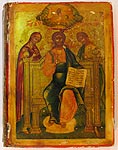Tetraevangelion.
Early 16th cent. 19th-century painting on front cover of binding.
Q (212 ű 155). 454 leaves.
Paper. Ink, cinnabar, colours, gold.
It is written in a large semi-uncial hand.
There are 4 portraits of the Evangelist (fols. 12v, 133v, 208v, 332r). Head-pieces and initials are in the New Byzantine style (fols. 14r, 134r, 209r, 334r). A head-piece on folio 422r are executed in a form a narrow bar.
The sixteenth-century binding consists of boards covered with leather. The upper board of the binding is decorated with a painting of the Deesis, made in the first half of the 19th century. The lower board shows traces (holes) of an onlaid centre piece, now lacking, in the form of a rhomb.
The inscription on the first folio of the manuscript states that the Gospel belonged to Metropolitan of All Russia Daniel (1522Ė1539), who was also a noted writer, an editor, a preacher, made an important contribution to history of medieval Russian book-learning. The manuscript is remarkable for its rich decoration. The codex was rebound in the first half of the 19th century at an Old Believers' icon painting workshop.
In 1818 the manuscript came into the Imperial Public Library along with the collection of Count F. A. Tolstoi.
Shelfmark: –ÕŃ. Q.I.25.





